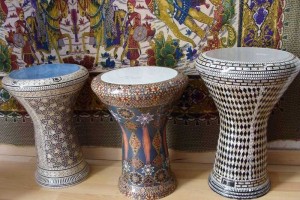Tracing the origins of darbuka

Music bands that play in Middle Eastern countries include at least two such drums, or their slightly larger versions known as sumbati and dohola. (Photo: Giselle Rodríguez )
It is the quintessential Middle
Eastern drum. Musicians have been playing this percussion instrument for over ten
centuries in a vast geographical region that covers Egypt, Morocco, Algeria,
Tunisia, Lebanon, Palestine, Iraq, Syria and Turkey. Its name varies throughout
the region, even though it is mostly known as derbake, darbuka, tablah or
doumbek.
According to Professor Philippe
Vigreux, the most recognized French specialist in the darabukka, as the instrument is known in
academic circles, its origins trace back to three percussion instruments played
in the Arab World during the Middle Ages: kabar, dirrij and kuba.
Drums with its current goblet shape
have been found in places like Spain, a legacy of the period of Al Andalus
during which the southern region of the country was ruled by Muslims from 711
to 1492.
Throughout time, it has been made of
different materials, such as clay, wood and metal, with fish or calf skin for the parchment. Gradually,
synthetic materials started being used for the drum's membrane. The
Metropolitan Museum of New York has a collection of this musical instrument
that includes examples from different countries, some of them as old as the 19th century. The instrument continues to be manufactured by
artisans throughout the Middle East as well as by professional workshops in
countries like Egypt, Lebanon, Turkey, Greece and even Russia that
export the drum world-wide.
Dum tak
Music bands that play in Middle
Eastern countries include at least two such drums, or their slightly larger
versions known as sumbati and dohola. With its dum and tak, as the two basic
sounds produced by the instrument are known, the drum reached the folk music of
non-Arab countries such as Greece and Yugoslavia through the influence of
Turkey.
Even though for some decades it was
considered an instrument more suitable for folk music, in the early 20th
century it started to be adopted by classical music. The darbuka appears in
many of the photos of the ensembles taken during the Arab Music Congress held
in 1932 at the National Music Academy in Cairo, Egypt.
Further north, Hasan
Tahsin Parsadan, a musician born in Kars, Turkey was the one who introduced
darbuka to Ottoman classical music at the beginning of the 20th century,
according to professor Nicholas Ragheb, whose Masters Degree dissertation
explored the instrument's history in the Anatolian peninsula.
Western musicians
like Hector Berlioz
(1855-58) included the darbuka
in his opera Les Troyens, while Darius Milhaud used it in a
Symphonic Suite composed in 1932. In the
60 and 70's of the last century, the darbuka started to position itself as the
lead percussion instrument in Middle Eastern music, a place long-held by the
riq, a type of tambourine, and the bendir, a frame drum, more commonly seen in
stone carvings in archaeological sites of the region.
From time immemorial this drum has
gladdened Arab celebrations such as parties, weddings and social gatherings
with its livening sounds. Belly dance shows offered in restaurants, night clubs
and 5-star hotels in countries such as Lebanon, United Arab Emirates, Egypt and
Turkey always include a drum solo in which the darbuka becomes the star in
complicity with the hip of the dancer.
Globalization and world music
introduced the instrument to the West in the modern era through artists like
Hossam Ramzy, a composer and percussionist from Egypt that has worked with artists such as Peter Gabriel, Robert Plant and Jimmy Page, and Natacha Atlas, a Belgian singer of Moroccan,
Egyptian and Palestinian ancestry.
Darbukas have not only been an
inspiration for musicians and their audiences but also for painters. Artists
such as Charles James Theriat, Otto Pilny, André Brouillet, George Paul Joseph
Darasse, Charles Landelle and Giulio Rosati included this percussion instrument in their
compositions.
A drum played by women?
There is also ample photographic
evidence of women playing darbukas from the late 18th century and early 19th
century. Female entertainers that played for female-only audiences were common
in Egypt, Algeria and Morocco because of the gender segregation brought by
Islam in the region, known for its ancestral musical tradition that originally
had spiritual purposes.
However, in the modern era the instrument is mainly played by
men, though there are virtuous female players like Samia Charbel, Raquy
Danziger or Simona Abdallah. Some of
the most renowned male players alive are Mısırlı Ahmet, his brother Levent Yildirim and Yasar Akpence from Turkey; Vagelis Karipis from Greece; Said el Artist from Egypt; Setrak Sarkissian from
Lebanon and Issam Houshan from Syria, just to mention some examples representative of the two different
techniques of playing darbuka: Turkish and Arab.
Ahmet, who took the instrument to a new level with his darbuka solo concerts, says: "it is a rhythm instrument with very rich tones and the ability to be played solo. All kinds of expressions can be presented via the darbouka."
In his own words "rhythm
is the most joyous path to take in the journey towards our inner world. Our
happiness, our grief, our enthusiasm and anger are voiced with all sincerity in
the goblet drum. You can experience an insatiable content as well as a restless
enthusiasm while beating the rhythms. Because the rhythm penetrates directly
into the heart, it functions like our heart."
May the echoes of the ancient
Babylon, Phoenicia, Egypt and Al Andalus continue resonating through this
drum for the times to come and soothing the spirit of a region sadly associated
with war, religious intolerance and geo-political conflicts in our days, a pale
shadow of the artistic zenith that it reached with the expansion of the Islamic
Empire, from
623 to 1050.
_______________________________________________________________________
About the author:
This story on the origins of darbuka is based on a comprehensive research done by Giselle Rodríguez, a
Mexican journalist and translator that is also a belly dance teacher, in collaboration with Jorge Luis Morales, a Mexican darbuka player. To read the full research in Spanish visit her
blog.





